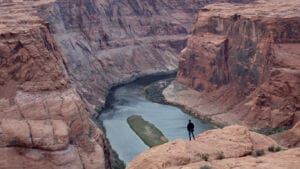Arizona is home to the largest contiguous ponderosa pine forest in North America, with a single stand stretching from near Flagstaff all the way to the White Mountains of the east.
And in the last 10 years, 25 percent of it burned, said Patrick Graham, Arizona state director for the Nature Conservancy.
Fire suppression and subsequent cleanup costs have risen far beyond estimated prevention costs, according to studies by the Nature Conservancy, Sierra Nevada Conservancy, the U.S. Forest Service and the Ecological Restoration Institute (ERI) at Northern Arizona University (NAU), among others.
The tourism industry in Arizona, an estimated 20 percent of the state’s economy, is largely dependent on the health of forested lands and other wildlife preserves, a 2007 report by the Governor’s Health Oversight Council stated.
But “wildfires affect the entire state — not just the north,” said Eric Marcus, executive director at the Northern Arizona Sustainable Economic Development Initiative.
A full-cost economic analysis of the 2010 Schultz fire outside of Flagstaff by the ERI revealed the deeper effect of forest fires. More than 15,000 acres of forest were burned, causing an estimated $147 million in economic damage, the report found. An investment of only $15 million could have prevented this catastrophe, said Marcus.
Fire and water
But most of the damage from these wildfires occurs after the fire has been extinguished.
When major wildfires remove the trees and grasses necessary for holding soil in place, a once standard rainstorm can now cause dangerous floods and massive erosion, filling up the reservoirs and ultimately decreasing the carrying capacity of our water supply, said Bruce Hallin, director of water rights and contracts with the Salt River Project.
“These catastrophic wildfires go in and the fire burns so hot that it burns everything,” said Hallin. “It turns it into this wasteland.”
But nothing can hold back sediment from flowing directly into the water supply if a fire were to ignite downstream from the reservoirs, such as the Sunflower fire in 2012. If ash-laden water were to be delivered to processing plants, treatment costs would increase dramatically, thus increasing the price of the water, said Marcus.
The 2002 Hayman fire in Colorado deposited more than 1 million cubic yards of sediment into Denver’s primary drinking water supply. To this day, cleanup is still underway to restore Strontia Springs Reservoir, with costs exceeding $150 million.
“Ultimately, through forest thinning, we don’t want to get to that point,” said Hallin.
One century ago, Arizona’s northern forests were more akin to open grasslands interspersed with towering ponderosas. Ignited by lightning, the grass beneath the trees would carry a smoldering fire along the ground, burning the young trees while only charring the thick bark of the older, more established ponderosas.
Need for thinning
But Arizona’s northern forests have “all departed from the way they were historically,” said Diane Vosick, director of policy and partnerships at ERI.
When grazing came through in the late 1800s and removed all of the grass, fires could no longer move through the forest naturally. Bare soil — which resulted from result over-grazing — allowed the pines to germinate seeds more easily. However, when fires did ignite, the U.S. Forest Service fire policy at the time required any and all fires to be extinguished. This fire policy went unchanged until 1995, allowing millions of young ponderosas and other vegetation to crowd the once-thin forest.
A study conducted by ERI Director Wally Covington found that historically, Arizona’s ponderosa forests contained roughly 25 trees per acre. But now, one acre of forest can contain more than a thousand trees.
“You’ve basically got a big wood pile out there waiting to burn,” said Vosick.
SRP, the water supplier for more than half of Phoenix and nearly all of Tempe, manages eight reservoirs deep within Arizona’s northern region.
“That’s the goal,” said Vosick. “You want fire to do its natural role and to help manage the forests.”
The Four Forest Restoration Initiative, or 4FRI, is a collaborative effort comprised of residents, industry, and the government to restore the Coconino, Kaibab, Apache-Sitgreaves and Tonto national forests through thinning and prescribed burning.
Vosick said that 4FRI hopes to have thinned at least 1 million acres of forested land within 20 years.
However, almost no thinning has taken place in nearly five years since the initiative began.
Seeking a solution
“Forest lands have been managed for the last 20 years through litigation and attorneys, not projects,” said Hallin. Because of these legal barriers, Northern Arizona’s timber industry has all but vanished. So even the lands that have been approved for thinning cannot receive the treatment prescribed because there is no longer any industry to do the work, he said.
“You can make money with big old trees, but we don’t want those trees taken out of the forest,” said Marcus. Private enterprise doesn’t want to invest because no money can be made from the small diameter trees, he said.
The only way to thin the forests in a timely manner is through convincing industry that their investment will not be inhibited by litigation because the federal government can’t do it by itself, Hallin said. “The fact of the matter is, without a successful forest products industry, that entire forest is going to burn.”
SRP, in conjunction with the National Forest Foundation, has created the Northern Arizona Forest Fund, enabling individuals and businesses to invest in restoring the lands that provide them water.
“We don’t need to do more research to know what our problem is; we need to generate public interest in fixing things,” said Marcus.
“You can pay me now, or you can pay me later. But if you pay me now, you pay me a fraction of what you’re going to pay me later and have nowhere near the devastating effects that you’re going to have down the road.”




